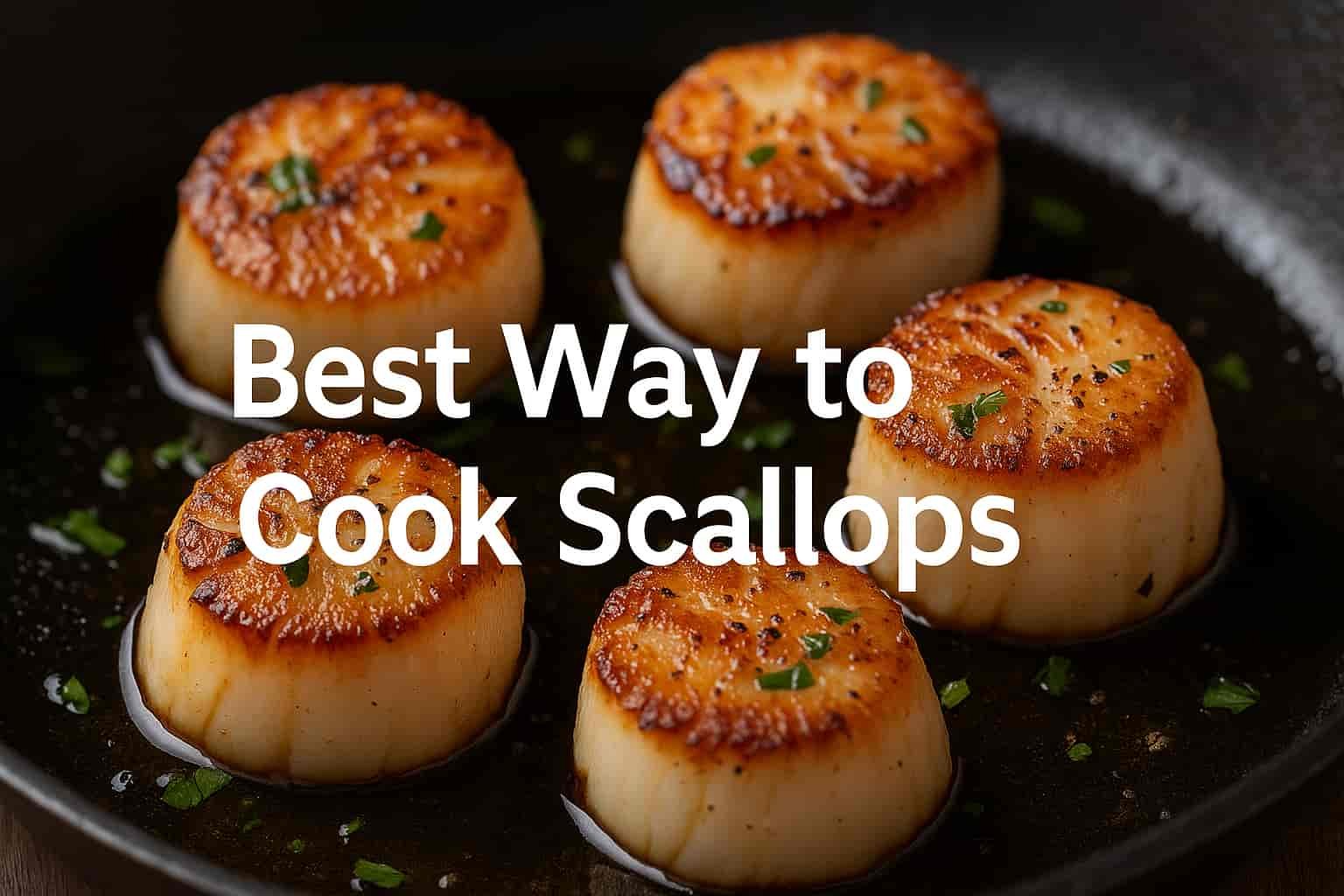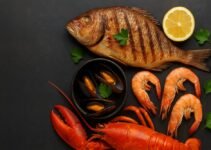Scallops are among the most prized seafood options, offering a naturally sweet flavor and a buttery, delicate texture when cooked correctly. Their high protein content, low fat, and rich supply of essential minerals make them a nutritional powerhouse. However, cooking scallops requires precision; even a 30-second error can turn them from perfectly tender to rubbery. Whether you’re focused on health benefits, taste, or culinary presentation, mastering the correct cooking method ensures optimal flavor and nutrition. This guide answers the most searched questions about scallop preparation, helping you achieve restaurant-quality results every time.
If you’re unsure how to select the freshest seafood before cooking, refer to our guide on How to Choose Fresh Seafood for expert tips.
Contents
- 1 What Is the Healthiest Way to Cook Scallops Without Losing Their Nutrients?
- 2 How Do You Properly Pan-Sear Scallops to Achieve a Perfect Crust?
- 3 Is It Better to Cook Scallops with or Without the Roe?
- 4 What Are the Common Mistakes That Ruin Scallops During Cooking?
- 5 How Long Should You Cook Scallops for Optimal Texture?
- 6 Can You Bake Scallops Without Making Them Rubbery?
- 7 Are Sous-Vide Scallops Better Than Traditional Cooking Methods?
- 8 What Are the Best Seasonings and Marinades for Cooking Scallops?
- 9 Is It Safe to Eat Raw or Lightly Cooked Scallops?
- 10 How Can You Tell If Scallops Are Fresh Before Cooking?
What Is the Healthiest Way to Cook Scallops Without Losing Their Nutrients?
The healthiest way to cook scallops is by steaming or grilling them without excessive oils or heavy sauces. These methods preserve their natural nutrients, including vitamin B12, omega-3 fatty acids, and magnesium. Steaming retains water-soluble vitamins, while grilling avoids the addition of unhealthy fats.
- Steaming keeps calorie content low, making it ideal for weight management and cardiovascular health.
- Grilling enhances flavor through natural caramelization without requiring added fats.
Both methods maintain scallops’ nutrient density, providing approximately 20 grams of protein and only 95 calories per 100 grams when cooked properly.
Should You Use Oil or Butter When Cooking Scallops for Health Benefits?
Use light olive oil instead of butter to reduce saturated fat intake while maintaining flavor. Olive oil contains heart-healthy monounsaturated fats and antioxidants. If using butter for taste, limit it to 1 teaspoon (5 grams) per serving to avoid excess calories and unhealthy fats.
How Does Grilling Scallops Affect Their Nutritional Value?
Grilling scallops slightly reduces their water content but preserves key nutrients like protein, selenium, and vitamin B12. The direct heat causes minor losses in heat-sensitive vitamins, but protein and mineral content remain stable. To minimize nutrient loss, grill scallops for exactly 2 minutes per side over medium-high heat.
How Do You Properly Pan-Sear Scallops to Achieve a Perfect Crust?
To achieve a perfect crust, scallops must be dry, seasoned lightly, and cooked at high heat for a short duration. This method triggers the Maillard reaction, creating a golden-brown crust while keeping the interior tender.
What Type of Pan Is Best for Searing Scallops?
A heavy-bottomed stainless steel or cast-iron skillet is the best choice for searing scallops. These pans provide even heat distribution and can reach the required high temperatures without hotspots. Avoid non-stick pans, as they prevent proper crust formation.
What Temperature Should You Use to Sear Scallops Without Overcooking Them?
Heat the pan to 400°F (204°C) before adding scallops, and sear for exactly 90 seconds per side. Overcooking beyond 3 minutes total leads to rubbery texture. The internal temperature should reach 115°F (46°C) for a perfect medium-rare center, ensuring tenderness with a caramelized crust.
Is It Better to Cook Scallops with or Without the Roe?
Cooking scallops without the roe is preferred for a cleaner, sweeter flavor, while keeping the roe adds a richer, more complex taste.
- Without Roe: Results in a milder, more delicate dish, preferred in Western culinary styles.
- With Roe: Introduces a slightly briny and creamy texture, popular in French and Asian cuisines.
How Does Roe Affect the Taste and Texture of Scallops?
Roe adds a creamy, oceanic richness and changes the texture to be slightly denser. It is high in omega-3 fatty acids and vitamin D, enhancing nutritional value but intensifying the seafood flavor.
Should You Remove the Roe for Certain Recipes?
Remove the roe when preparing light dishes like pan-seared scallops or ceviche to highlight the scallops’ natural sweetness. Retain the roe for richer recipes, such as seafood stews or butter-based sauces, where its creaminess complements the dish.
What Are the Common Mistakes That Ruin Scallops During Cooking?
The most common mistakes when cooking scallops include overcooking, overcrowding the pan, and failing to dry them properly. These errors directly affect texture, flavor, and appearance, often resulting in rubbery or soggy scallops.
- Overcooking leads to moisture loss and a tough, chewy texture. Scallops should be cooked for no more than 90 seconds per side.
- Overcrowding the pan reduces heat, preventing proper searing and leading to steaming instead of caramelization.
- Not drying scallops thoroughly causes excess moisture, which prevents crust formation and creates a pale, uneven surface.
How Does Overcrowding the Pan Affect Scallop Cooking?
Overcrowding reduces the pan’s temperature and prevents the Maillard reaction necessary for a golden-brown crust. Scallops release moisture during cooking, and when crowded, this moisture cannot evaporate quickly enough. As a result, scallops end up being steamed rather than seared, losing both flavor and texture.
Why Is It Important to Pat Scallops Dry Before Cooking?
Patting scallops dry with a paper towel ensures a better sear and prevents excess moisture from interfering with caramelization. Water on the surface creates steam, which cools the pan and disrupts the browning process. Always dry scallops until no visible moisture remains before placing them in a hot pan.
How Long Should You Cook Scallops for Optimal Texture?
Scallops should be cooked for exactly 90 to 120 seconds per side depending on their size to achieve a tender center and caramelized exterior. Overcooking even by 30 seconds results in a tough, rubbery texture due to protein contraction and moisture loss.
- Sea Scallops (Large): Cook for 2 minutes per side.
- Bay Scallops (Small): Cook for 1 to 1.5 minutes per side.
Use a thermometer to confirm that the internal temperature reaches 115°F (46°C) for a perfect medium-rare finish.
What Is the Ideal Internal Temperature for Perfectly Cooked Scallops?
The ideal internal temperature for scallops is 115°F (46°C). This ensures the interior remains tender while the exterior develops a flavorful crust. Cooking beyond 130°F (54°C) causes the proteins to tighten excessively, resulting in a rubbery texture.
How Do Cooking Times Differ Between Sea Scallops and Bay Scallops?
Sea scallops require approximately 2 minutes per side, while smaller bay scallops only need 1 to 1.5 minutes per side. The larger size and denser muscle fibers of sea scallops require slightly longer cooking times. Always adjust based on size and monitor closely to prevent overcooking.
Can You Bake Scallops Without Making Them Rubbery?
Yes, you can bake scallops without making them rubbery by controlling temperature and cooking time precisely. Bake at a moderate temperature of 375°F (190°C) for 12 to 15 minutes, depending on the size of the scallops. Overbaking leads to moisture loss and tough texture.
What Is the Recommended Oven Temperature for Baking Scallops?
The recommended oven temperature for baking scallops is 375°F (190°C). This temperature allows the scallops to cook evenly without drying out. Use a preheated oven to maintain consistent heat throughout the baking process.
How to Prepare a Simple and Healthy Baked Scallop Recipe?
To prepare a healthy baked scallop dish:
- Preheat the oven to 375°F (190°C).
- Pat scallops dry and place them in a single layer in a baking dish.
- Drizzle with 1 tablespoon of extra virgin olive oil and season with 1/4 teaspoon of sea salt and 1/8 teaspoon of black pepper.
- Add fresh herbs like parsley or thyme for extra flavor.
- Bake uncovered for 12 to 15 minutes until the internal temperature reaches 115°F (46°C).
Are Sous-Vide Scallops Better Than Traditional Cooking Methods?
Sous-vide scallops deliver precise, consistently tender results that are difficult to achieve with traditional methods. This technique locks in moisture and preserves the scallops’ natural sweetness without the risk of overcooking. While pan-searing creates a crisp exterior, sous-vide ensures perfect internal doneness.
- Key Advantage: Controlled cooking at low temperatures prevents protein over-contraction, maintaining a buttery, melt-in-the-mouth texture.
- Consideration: Sous-vide requires finishing with a quick sear to develop a flavorful crust.
What Temperature and Time Settings Are Best for Sous-Vide Scallops?
Set the sous-vide water bath to exactly 123°F (51°C) and cook the scallops for 30 to 35 minutes. This temperature ensures the scallops reach a perfect, tender texture without losing moisture. After sous-vide cooking, pat them dry and sear in a hot pan for 30 seconds per side to achieve a caramelized crust.
How Do You Finish Sous-Vide Scallops for a Perfect Sear?
To finish sous-vide scallops, heat a cast-iron skillet to 400°F (204°C), add a small amount of high-smoke-point oil like avocado oil, and sear for exactly 30 seconds per side. This technique forms a golden crust through the Maillard reaction without overcooking the interior.
What Are the Best Seasonings and Marinades for Cooking Scallops?
The best seasonings for scallops enhance their natural sweetness without overpowering their delicate flavor. Simple combinations work best to highlight the fresh, oceanic taste.
- Best Seasonings: Sea salt, cracked black pepper, garlic powder, smoked paprika, and lemon zest.
- Best Herbs: Fresh thyme, parsley, and chives.
- Ideal Marinade: Mix 2 tablespoons olive oil, 1 teaspoon lemon juice, 1/4 teaspoon sea salt, and 1/8 teaspoon ground black pepper. Marinate for no more than 15 minutes to prevent the acid from breaking down the scallops’ proteins.
Which Spices Enhance the Natural Sweetness of Scallops?
Mild spices such as smoked paprika, garlic powder, and white pepper highlight scallops’ natural sweetness without overwhelming their delicate flavor. Avoid using strong spices like cumin or curry powder, which can dominate the taste profile.
Should You Marinate Scallops Before Cooking or After Searing?
Marinate scallops lightly before cooking for flavor infusion but avoid acidic marinades for longer than 15 minutes. Extended marination with acids like lemon or vinegar causes the proteins to denature prematurely, resulting in a mushy texture. After searing or grilling, you can finish with a light drizzle of infused oils or herb butter to enhance flavor.
Is It Safe to Eat Raw or Lightly Cooked Scallops?
It is safe to eat raw or lightly cooked scallops if they are sushi-grade and properly handled. Raw scallops are commonly served in ceviche, sashimi, and crudo dishes. However, consuming raw seafood carries a risk of foodborne illness if the scallops are not sourced from reputable suppliers.
- Safe Temperature: When lightly cooked, ensure an internal temperature of at least 115°F (46°C).
- Source Verification: Always purchase from certified suppliers offering sushi-grade scallops to reduce contamination risk.
What Are the Risks of Consuming Raw Scallops?
The primary risks include exposure to Vibrio bacteria and parasites, which can lead to foodborne illnesses such as vibriosis. Symptoms may include nausea, diarrhea, and abdominal pain. Vulnerable groups—including pregnant women, elderly individuals, and people with weakened immune systems—should avoid consuming raw scallops.
How to Prepare Scallop Ceviche Safely at Home?
To prepare safe scallop ceviche at home:
- Purchase certified sushi-grade scallops.
- Slice scallops into uniform, thin pieces.
- Soak in freshly squeezed lime or lemon juice (enough to fully submerge the scallops) for 20 minutes. The citric acid will partially denature proteins, mimicking the cooking process.
- Add diced red onions, cilantro, and sliced chilies for flavor.
- Serve immediately and consume within 2 hours to ensure freshness and safety.
How Can You Tell If Scallops Are Fresh Before Cooking?
You can tell if scallops are fresh by checking their color, smell, and texture. Fresh scallops have a translucent, creamy-white appearance with a slight pink or beige hue. They should smell like the ocean—clean and slightly salty—but never fishy or sour. Their texture should be firm and spring back gently when pressed.
What Visual and Smell Indicators Show Scallops Are Safe to Eat?
- Visual Indicators:
- Fresh scallops have a moist, shiny surface without any dryness or cracks.
- Avoid scallops that appear dull, gray, or have excessive milky liquid, which signals spoilage.
- Smell Indicators:
- Fresh scallops should have a mild ocean scent.
- A strong fishy or ammonia-like smell indicates bacterial growth and spoilage.
How Should You Store Scallops to Keep Them Fresh Until Cooking?
Store scallops at temperatures below 32°F (0°C) in the coldest part of your refrigerator. Follow these precise steps to maintain freshness:
- Place scallops on a bed of crushed ice in a shallow container.
- Cover loosely with parchment paper or a breathable cloth to allow airflow.
- Refresh the ice every 8 to 12 hours.
- Consume within 24 to 48 hours of purchase for optimal quality.
For longer storage, freeze scallops immediately at 0°F (-18°C). Use vacuum-sealed bags to prevent freezer burn, and consume within 3 months for best texture and flavor.
Scallops represent a perfect balance of flavor, texture, and nutritional value when prepared correctly. Mastering techniques like steaming, pan-searing, baking, and sous-vide ensures consistently delicious results while preserving their health benefits. Always prioritize sourcing fresh scallops, handle them with care, and apply precise cooking times to avoid the most common preparation mistakes. Whether you’re creating a light, healthy meal or an indulgent fine-dining experience, following these expert techniques will allow you to serve scallops at their absolute best—every time.



